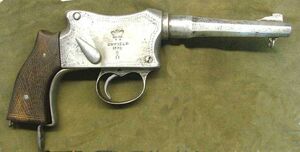
A Khyber Pass copy of a Martini-Henry rifle, made into a pistol.
A Khyber Pass copy is a firearm manufactured by cottage gunsmiths in the Khyber Pass region between Pakistan and Afghanistan. They get their name from the Adam Khel Afridi, who live around the Khyber pass and were historically the most active arms manufacturers on the Frontier. The area has long had a reputation for producing unlicensed, home-made copies of firearms using whatever materials are available - more often than not, railway rails, scrap motor vehicles and other scrap metal. The quality of such rifles varies widely, ranging from as good as a factory-produced example to dangerously poor.
Examples[]
The most commonly encountered Khyber Pass copies are of British military firearms, notably Martini-Henry, Martini-Enfield, and Lee-Enfield rifles, although AK-47 rifles, Webley revolvers, Tokarev TT-33s, Colt M1911s and Browning Hi-Powers have also been encountered. A Khyber Pass Kalashnikov-style rifle usually refers to such a rifle composed of a mishmash of parts from various AK rifles. It is thus unlike any rifle produced by a factory or issued by a regular military force. The typical example of a "Khyber Pass AK" is a stamped receiver AKM in 7.62x39 caliber, fitted with the triangular folding stock common to Russian AKS-74 rifles. The Khyber Pass gunsmiths first acquired examples of the various British service arms during nineteenth century British military expeditions in the North-West Frontier, which they used to make copies. During World War II, some locally organized Irregular Forces were issued Khyber Pass made rifles - partly for financial reasons and partly because there was concern the troops would steal their rifles and desert if issued higher-quality British or Indian manufactured rifles.
ID[]
Khyber Pass rifles are usually copied exactly from a "master" rifle (which may itself be a Khyber Pass Copy), markings and all. It is not uncommon to see Khyber Pass rifles with numerous errors and particular identifying factors, notably:
- Spelling errors in the markings (the most common of which is EИFIELD for ENFIELD)
- V.R. (Victoria Regina) cyphers dated after 1901 - Queen Victoria died in 1901, so any rifles made after this should be stamped "E.R" (Edward Rex, referring to King Edward VII)
- Generally inferior workmanship including weak or soft metal, poorly finished wood, and badly struck markings.
Afghanistan was a point of conflict between the British Empire and Imperial Russia throughout the 19th Century, from which it is reasonable to assume that tools and expertise relevant to both cultures were accumulated by native gunsmiths. Hence despite an untrained eye assuming that a reversed "N" or "L" in ENFIELD is simply a transcription error, a toolmaker or linguist will recognise that they are actually the Cyrillic "И" and "Г" characters, with the gunsmith using whatever letter punches he had available.
Ammo[]
The ammunition used in the Khyber Pass region is often underloaded, being made from a variety of powders or even old film (which contains nitrocellulose, a key component of smokeless powder); Khyber Pass Copy rifles cannot be expected to withstand the pressures generated by modern commercial ammunition. A few collectors have made extremely mild handloaded cartridges for their Khyber Pass rifles and fired them, at substantial personal risk.